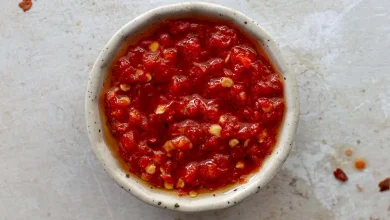🍗🍑👩🍳
Apricot-Glazed Chicken is a delightful dish that combines the savory flavor of chicken with the sweet and slightly tart taste of apricot glaze. This dish is known for its balance of flavors, making it a popular choice for those who enjoy a sweet and savory combination.
History:
The history of Apricot-Glazed Chicken is not well-documented, but it likely emerged as a fusion of different culinary traditions that combined poultry with sweet fruit-based sauces. Apricots have been cultivated for thousands of years, and their use in cooking can be traced back to ancient Persia. Over time, this fruit and its use in various dishes, including chicken, spread across different cultures and cuisines.
Components:
- Chicken: You can use boneless, skinless chicken breasts or thighs for this dish.
- Apricot Glaze: The glaze is made from apricot preserves, which are cooked down to a syrupy consistency. You can add additional ingredients like Dijon mustard, soy sauce, and spices to enhance the flavor.
Steps to Prepare Apricot-Glazed Chicken:
-
Prep the Chicken: Start by seasoning your chicken with salt and pepper. You can also add other spices or herbs for extra flavor.
-
Sear the Chicken: Heat a pan with some oil over medium-high heat. Once hot, add the chicken and sear it until it’s golden brown on both sides. This step ensures the chicken gets a nice, crispy texture.
-
Make the Apricot Glaze: In a separate saucepan, combine apricot preserves, Dijon mustard, soy sauce, and any other desired seasonings. Cook this mixture over low heat until it thickens into a glaze.
-
Glaze the Chicken: Once the chicken is seared, pour the apricot glaze over it in the pan. Use a spatula to coat the chicken evenly with the glaze.
-
Finish in the Oven: Transfer the pan to a preheated oven (around 375°F or 190°C) and bake for about 15-20 minutes, or until the chicken is fully cooked. The glaze will caramelize and become sticky and delicious.
-
Serve: Remove the chicken from the oven and let it rest for a few minutes. Then, serve it with the remaining apricot glaze drizzled over the top. You can garnish it with fresh herbs like parsley or chives for a burst of color and flavor.
Time Needed:
The total time needed to prepare Apricot-Glazed Chicken can vary, but on average, you can expect it to take around 45 minutes to an hour. This includes prep time, searing the chicken, making the glaze, baking, and resting. It’s a reasonably quick and easy dish to make, perfect for a weeknight dinner or a special occasion.
Enjoy your delicious Apricot-Glazed Chicken! 🍗🍑😋
Certainly! Here are the nutrition facts and some health information for Apricot-Glazed Chicken:
Nutrition Facts (Approximate values per serving):
- Calories: 300-400 kcal
- Protein: 25-30g
- Carbohydrates: 20-30g
- Dietary Fiber: 1-2g
- Sugars: 15-20g
- Fat: 10-15g
- Saturated Fat: 2-3g
- Cholesterol: 70-100mg
- Sodium: 300-400mg
Health Information:
-
Protein: Chicken is an excellent source of lean protein, which is essential for muscle maintenance and overall body function.
-
Carbohydrates: The carbohydrates mainly come from the apricot glaze. While it provides energy, it’s essential to be mindful of the sugar content in the glaze.
-
Dietary Fiber: There is a small amount of dietary fiber in the dish, primarily from the apricots. Fiber is important for digestive health.
-
Sugars: The sugar content in the apricot glaze is relatively high, which contributes to the sweet flavor of the dish. It’s essential to be aware of sugar intake, especially if you have dietary restrictions.
-
Fat: Chicken contains some fat, which is part of a balanced diet. The amount of fat can vary based on the cut of chicken and how it’s prepared.
-
Saturated Fat: Saturated fat is typically lower in chicken breast compared to dark meat. Reducing saturated fat intake is generally recommended for heart health.
-
Cholesterol: Chicken contains cholesterol, but the levels in chicken breast are relatively low compared to other meats. It’s still a good idea to monitor cholesterol intake.
-
Sodium: The sodium content primarily comes from the soy sauce in the apricot glaze. Be cautious of sodium intake, especially if you have high blood pressure or are watching your salt intake.
-
Balance: Apricot-Glazed Chicken can be a balanced dish if you control portion sizes and balance it with plenty of vegetables or salads.
-
Customization: You can make this dish healthier by choosing lean cuts of chicken, reducing the sugar in the glaze, and adjusting the ingredients to meet your dietary needs.
Remember that the exact nutrition content may vary based on the specific recipe and portion size. If you have specific dietary concerns or restrictions, it’s a good idea to consult with a nutritionist or dietitian to tailor this dish to your needs.



